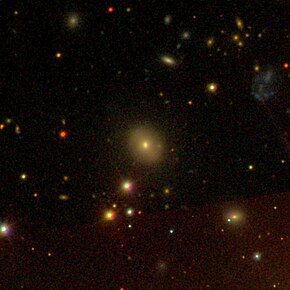NGC 503
| NGC 503 | |
|---|---|
 SDSS view of NGC 503 | |
| Observation data (J2000[1] epoch) | |
| Constellation | Pisces[2] |
| Right ascension | 01h 23m 28.4s[3] |
| Declination | +33° 19′ 54″[3] |
| Redshift | 0.01975 ± 0.00007[1] |
| Heliocentric radial velocity | (5862 ± 21) km/s[1] |
| Distance | 265 Mly[4] |
| Apparent magnitude (V) | 14.1[2] |
| Apparent magnitude (B) | 15.1[2] |
| Characteristics | |
| Type | E-S0[2] |
| Apparent size (V) | 0.9' × 0.7'[2] |
| Other designations | |
| PGC 5086, GC 5169, MGC +05-04-040, 2MASS J01232845+3319542 [1][5] | |
NGC 503, also occasionally referred to as PGC 5086 or GC 5169, is an elliptical galaxy in the constellation Pisces.[2] It is located approximately 265 million light-years from the Solar System[4] and was discovered on 13 August 1863 by German astronomer Heinrich Louis d'Arrest.[5]
Observation history[edit]
Arrest discovered NGC 503 using an 11" reflecting telescope in Copenhagen. His position matches perfectly with PGC 5086. At the time of discovery, he considered the possibility of having observed one of William Herschels discoveries (NGC 495, 496, 499).[6] John Louis Emil Dreyer, creator of the New General Catalogue, described the galaxy as "extremely faint, extremely small" with a "double star 4 arcmin to southwest".[5]
See also[edit]
References[edit]
- ^ a b c d "NGC 503". Retrieved 2017-12-09.
- ^ a b c d e f "Revised NGC Data for NGC 503". spider.seds.org. Retrieved 2017-10-05.
- ^ a b "Your NED Search Results". ned.ipac.caltech.edu. Retrieved 2017-10-05.
- ^ a b An object's distance from Earth can be determined using Hubble's law: v=Ho is Hubble's constant (70±5 (km/s)/Mpc). The relative uncertainty Δd/d divided by the distance is equal to the sum of the relative uncertainties of the velocity and v=Ho
- ^ a b c "New General Catalog Objects: NGC 500 - 549". cseligman.com. Retrieved 2017-10-16.
- ^ "astronomy-mall.com/Adventures.In.Deep.Space/NGC%201-7840%20complete.htm".
External links[edit]
Wikimedia Commons has media related to NGC 503.
- NGC 503 on WikiSky: DSS2, SDSS, GALEX, IRAS, Hydrogen α, X-Ray, Astrophoto, Sky Map, Articles and images
- SEDS
